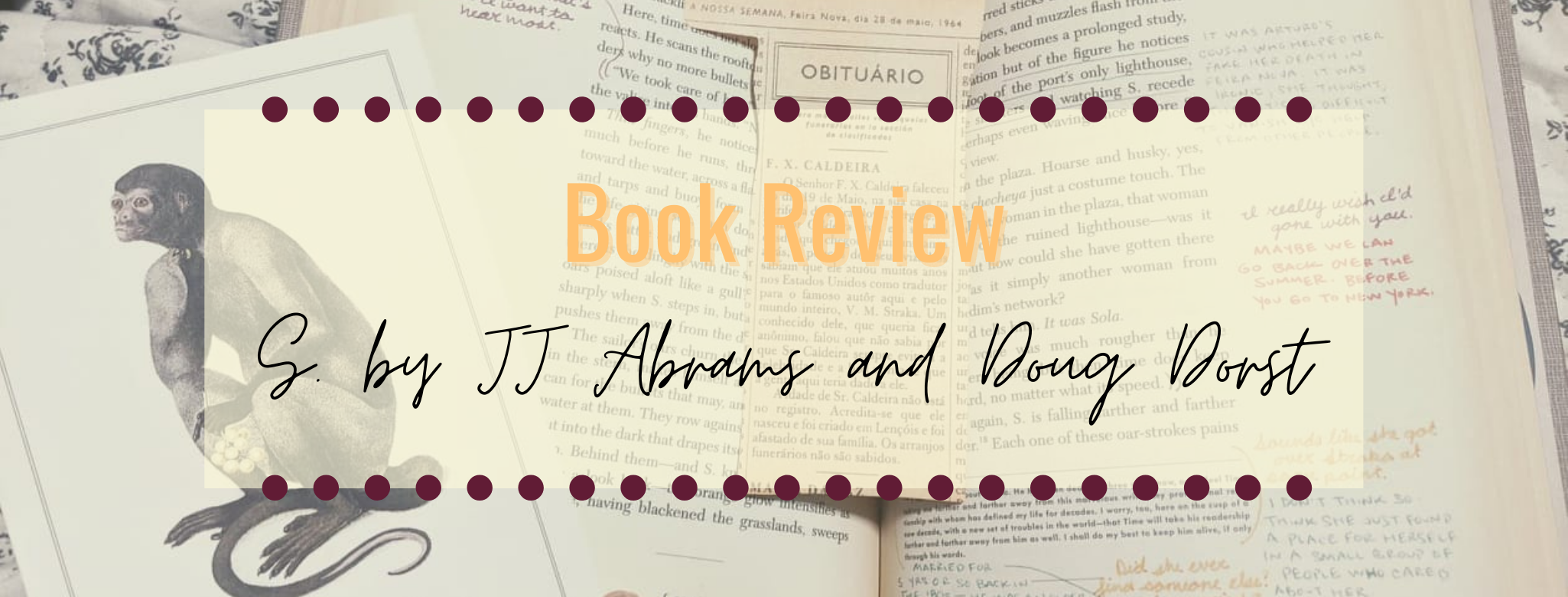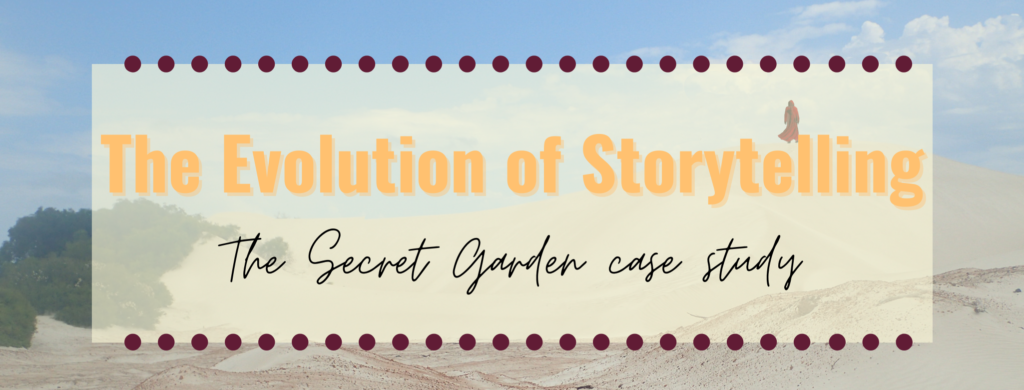For many readers, Shifting Sands might seem original – like it’s doing something new – and in some ways it is. I haven’t found anyone else who uses the ability to make changes in an ebook after publication as a mechanic, at least. There are, however, plenty of authors who have used other mechanics to play with the concept of the book and experiment with new ways of storytelling. Some, like Shifting Sands, exploit the potential of the ebook, adding hyperlinked footnotes to let you explore a story. Others remove the book entirely, creating web-based stories that use the many possibilities this presents. But some chose to keep the book, instead playing with its materiality and ‘bookishness’. Today, I want to look at one of those by doing a book review of S. by JJ Abrams and Doug Dorst.
Why S.?
Last week’s examination of The Secret Garden reminded me of how much I love doing reviews. I have another blog entirely devoted to reviewing things. It’s been a while since I last posted but I’ll get back to it someday. Adding that to the focus of my research, it makes sense to do a book review of S. and others like it to explore where Shifting Sands fits in. But why S. first, you may ask? There’s probably no rational reason but I guess you could argue that it’s because I see a number of similarities between S. and Shifting Sands. I’ll get into that more as we go along though because first we need a summary!
Like many books that experiment in this way, S. isn’t the easiest thing to sum-up but I’ll try my best. There are essentially three books in one with this story. First, there’s the main body, which follows a man with no memory thrust into a strange ship on an adventure to find himself. The story around this story focused on the secret author, Stratka, whose life (and death) is enshrouded in mystery and conspiracy theories. And then we have the story in the margins, of two students who meet through the notes they leave on a library copy of Stratka’s novel and become embroiled in the mystery of Stratka.
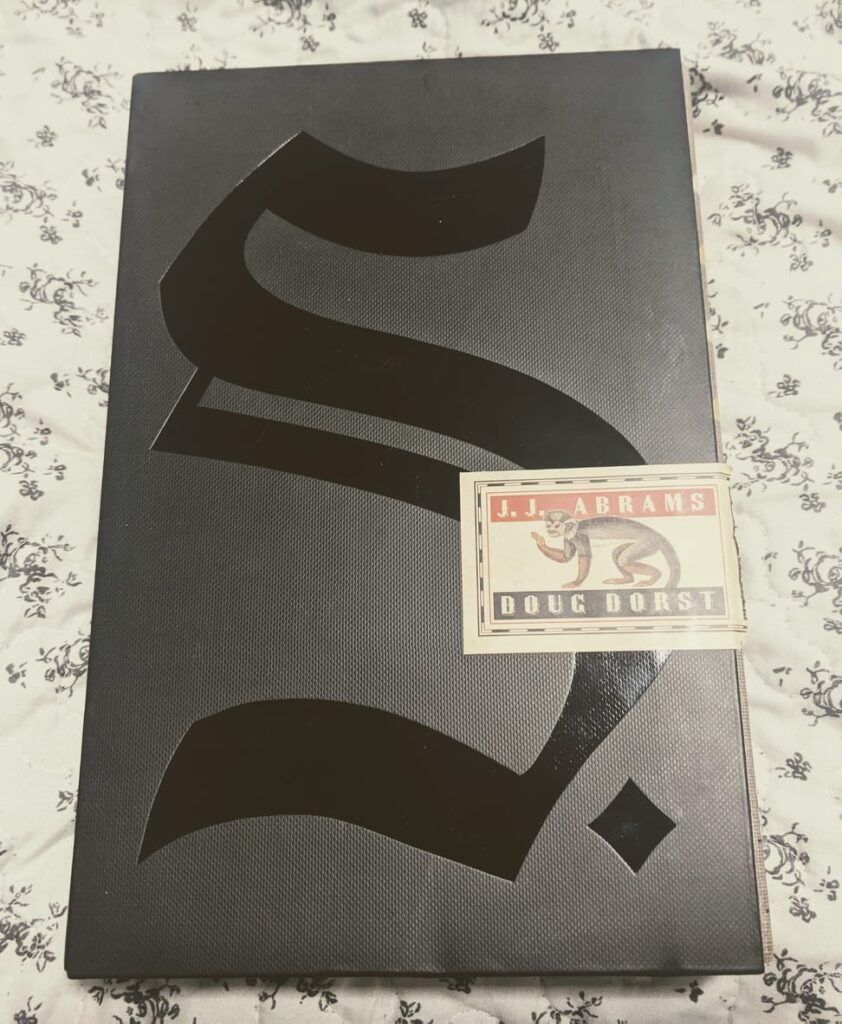
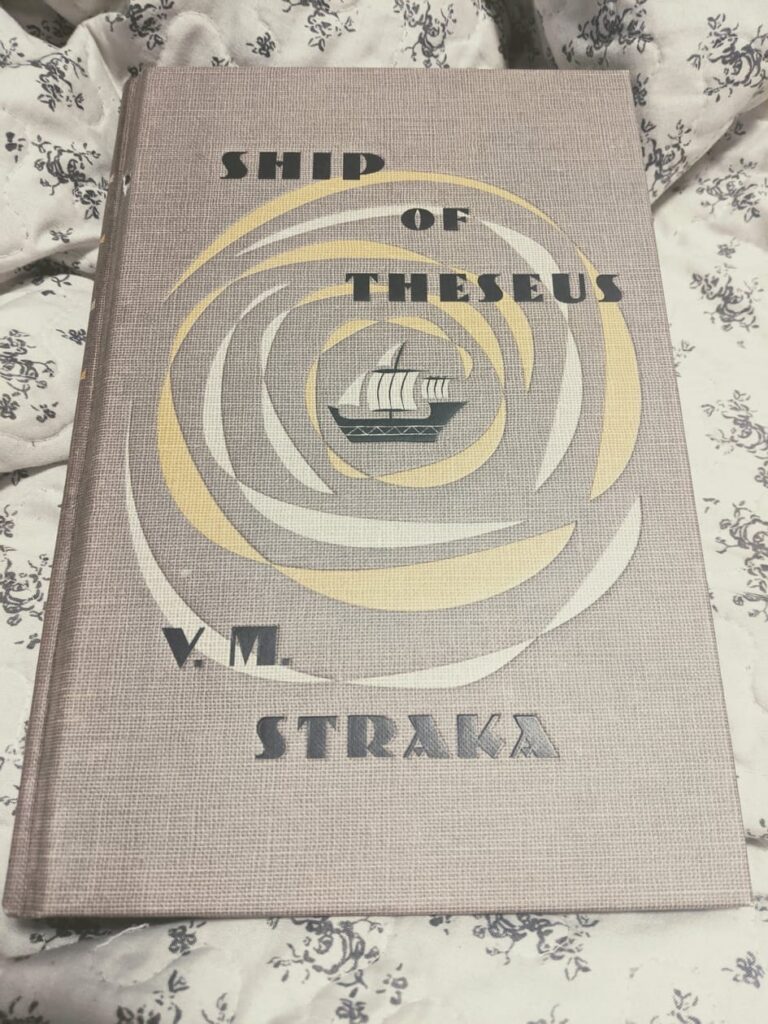
Materiality in S.: reviewing aesthetics
I remember, when I was younger, disregarding the importance of what a book looks like. When the text transports you to another world, does it matter what its container is like beyond that initial prompt to buy? And yet this feeling can be immediately contrasted with my love for the early covers of both the Stravaganza series, with its cut-outs, and Hunger Games, with changeable cover. S. further cements the death of this theory because so much of its interest comes from its materiality. The fact it’s a book and the way it looks as a book are tied to the story and add to the immersive experience.
S. looks like a library book. There’s even a sticker indicating where on the Dewey Decimal system it belongs. It feels old, like a book that’s been buried on shelves for years. But that’s just the outside. Inside, it gets even more interesting. You see, the main text – the story of the man who’s forgotten everything – is just about the only bit that feels like a normal book. The other stories are told through marginalia and inserts. Evidence of Stratka’s life and mysteries to uncover come in the form of postcards and pictures slotted between pages. There’s even a napkin. And then, in margins and notes to one another, Jen and Eric converse, discussing the Stratka mystery and building a relationship with one another. These notes are a jumbled timeline, with updates and additions indicated by changing ink colours appearing randomly through the book, while the inserts can easily become shuffled and in need of relocation to further the text. As a book, it fully embraces its materiality and exploits it.
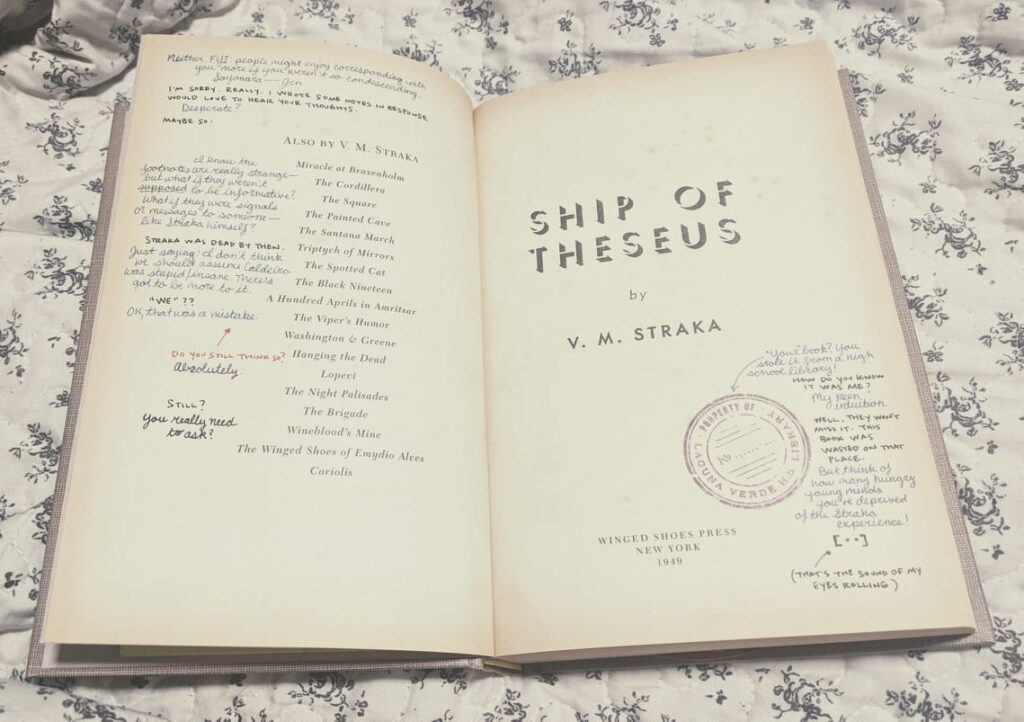
A Review of the Main Body
There are many ways to read S. and, I imagine, many more ways to craft a book review of it. For ease, I’m going to break it down into its component parts before doing an overview. So, starting with the main body text, it has always been my least favourite part of S., but I think my appreciation is growing. This book rewards you for rereading and, as I’m discovering, for reading more widely. Yes, out of all the sections, it feels the most traditional and “literary”, but it’s sneaky. You see, the main body blatantly plays with the idea of the Ship of Theseus but, if you think that’s the only place, you’re not reading closely enough.
To briefly sum-up the Ship of Theseus idea, if a ship has had all its component parts replaced over time, is it the same ship? The man (the eponymous S.) and the ship in his story are changed throughout their long journey. On first reading, I could see the connections to Greek mythology, with long sea-faring adventures, heroes who forget who they are, and mysterious women who ensnare hem for a time. But I now also see connections to Orlando by Virginia Woolf. In Orlando, the eponymous character travels through many lives, changing body but not seeing themselves as having changed greatly inside. And yet, they have grown as a character and so have changed, surely? S. feels the same – a long journey, where the character feels both the same and different at the end all at once.
As a reader, despite my instinctive balking at the “literariness” of it all, I am learning to appreciate the main body more. It holds so clues that seem neglected in so many of the other reviews of the book, particularly when it comes to theme. Everyone wants to dig into the mystery. I need to re-read this part more to see what else I discover, but that’s the way things go with S.. You always need to read it again.
A Review of the Stratka Storyline
As mentioned above, most sites I can find on S. obsess over the Stratka mystery above all else. I definitely get this. Reading S., and particularly the Stratka mystery, is like finding yourself in an escape room. Except it’s a book. And you’re not escaping, you’re trying to find something. And you don’t know which clues are real and which are false. It’s thrilling and mind-blowing all at once and, in all honesty, probably one of the things that makes S. so great.
I will fully admit, I don’t think I’m smart enough for the Stratka mystery. I certainly didn’t pick up on all the clues in my first read. Admittedly, I first read it after borrowing the book. I then promptly forgot to read it, so frantically had to dive through it the day before I gave it back. I don’t recommend this for your first read! As such, the solution to the (main) mystery felt like a huge surprise to me and came in one big rush. It’s kind of like watching the Sixth Sense though; knowing the solution to the mystery doesn’t lessen the experience, but rather gives you new ways to look at the text. There are clues that, even now, readers are uncovering on fan sites that shed new light on the story.

A Review of the Jen and Eric story
Out of all the component parts of S., the story told in margins is my favourite. Despite me realising more about the other parts, I think it always will be. I’m a sucker for a building friendship, and even more so for a little romance. Jen is a final year undergrad lit student who stumbles upon postgrad Eric’s (stolen) copy of S., has a quick read, and then leaves it for him to find again with a note from her inside. He leaves it for her to read fully with his own note, encouraging her to look deeper, and this sets them off on a journey together to uncover Stratka’s mystery.
As noted above, this part of the story is told through the margins and inserts, meaning nothing is linear. You can find notes from Jen and Eric on their first ‘wave’ through the story on one page, right alongside notes from them at the end of their story. As a reader, you learn what notes come from which time based on familiarity (or google, if you so choose). I love this because you can see their growth. Not only does their understanding of the mystery change, but so too does their understanding of each other. There’s a really cute exchange that happens early on, first between Jen and Eric at the start and then with additions from them at the end. I love it. The literariness of the main text and the complexity of the mystery can be exhausting, but I live for the Jen and Eric exchanges.
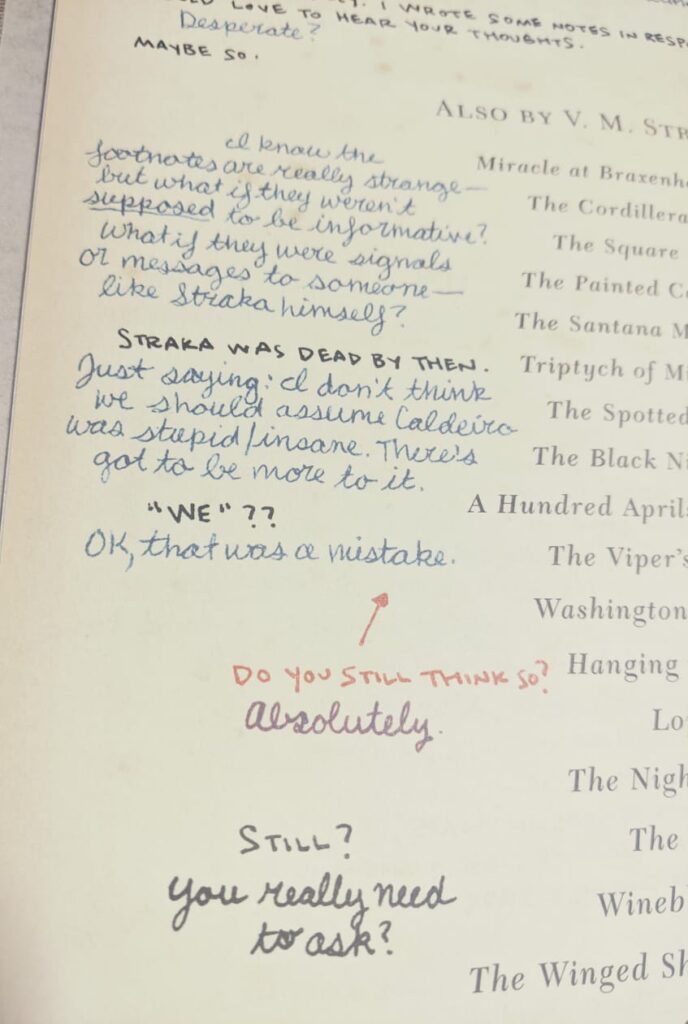
S. Overall Book Review
S. is a book that rewards you for rereading. It’s impossible to understand everything on your first pass through, no matter what way you read it. But that makes it exciting. There are so many aha moments, each time you read, and that’s without engaging in any of the online communities related to the book. As with the Ship of Theseus, you, as a reader, grow and change each time you come back to it. Are you the same reader you were when you first started?
S. feels like a celebration of bookishness and I love it. There are a few books I can think of that similarly experiment with stability and materiality, but S. is the only one I can think of that also ropes in book culture. It celebrates the form of the book. But, more specifically, it celebrates the form of the library book, thus making us think of how we treat books and how they are used. There’s also something in there about our relationship with authors. I have to admit I’d need to reread again to dig into that more though. There’s just something so exciting with the way it plays with the reader’s knowledge of books, both rewarding and subverting these expectations in turn. If you consider yourself a book lover and like a mystery, I’d say it’s a must-read.
S. and Shifting Sands
As someone whose research falls into questioning bookishness and experimenting with what we can do with books, I found it interesting to reflect on what my book review of S. says about my own writing. While S. plays with the materiality of the book and Shifting Sands can only ever be an ebook, there are similarities.
First, and I guess most obviously, there are the literary connections. S. clearly draws from Greek stories such as the Iliad and Homer’s Odyssey. Shifting Sands similarly draws on my familiarity with myth and storytelling. But, more importantly, both reward you for rereading. If you read S. only once, you’re going to miss clues. If you read Shifting Sands only once, you’ve only gotten half the story. So, I guess the big take away for this blog post is, look forward to the big Shifting Sands shuffle on March 17th? And talk to me about S. if you’ve read it!
